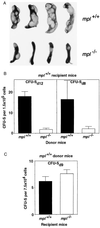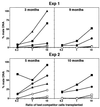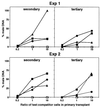Hematopoietic stem cell deficiencies in mice lacking c-Mpl, the receptor for thrombopoietin - PubMed (original) (raw)
Hematopoietic stem cell deficiencies in mice lacking c-Mpl, the receptor for thrombopoietin
S Kimura et al. Proc Natl Acad Sci U S A. 1998.
Abstract
Thrombopoietin (TPO) acts as a lineage-specific late-acting factor to stimulate megakaryocyte and platelet formation. However, analysis of mice lacking either the cytokine or its receptor, c-Mpl, also revealed deficiencies in progenitor cells of multiple hematopoietic lineages, suggesting that TPO signaling may play an important role in the regulation of the hematopoietic stem cell compartment. To investigate this hypothesis, we determined preprogenitor and colony forming unit-spleen (CFU-S) numbers and analyzed the long-term hematopoietic repopulating capacity of bone marrow cells from mpl-/- mice. mpl-/- mice had 4- to 12-fold fewer preprogenitor cells than wild-type mice. In irradiated normal recipients, mpl-/- bone marrow generated 8- to 10-fold fewer spleen colonies than wild-type marrow at both 8 and 12 days after transplantation. This defect was intrinsic to the transplanted hematopoietic cells, as the microenvironment of mpl-/- recipients supported similar CFU-S growth to that observed in wild-type recipients. In definitive assays of stem cell function, bone marrow cells from mpl-/- mice failed to compete effectively with normal cells for long-term reconstitution of the hematopoietic organs of irradiated recipients, even when transplanted in 10-fold excess. Serial transplantation studies further suggested that stem cell self-renewal also may be compromised in mpl-/- mice. These data imply that TPO, signaling through c-Mpl, plays a vital physiological role in the regulation of hematopoietic stem cell production and function.
Figures
Figure 1
Reduced numbers of CFU-S in _mpl_−/− mice. (A) Appearance of spleens from irradiated wild-type recipient mice 12 days after intravenous injection of 7.5 × 104 wild-type (mpl+/+) or 1.5 × 105 _mpl_−/− bone marrow cells. (B) Spleen colony numbers per 1.5 × 105 wild-type or _mpl_−/− bone marrow cells transplanted into normal irradiated recipient mice. Data are the means ± SDs from five or six (CFU-Sd12) or two (CFU-Sd8) individual donor mice of each genotype, each transplanted into five recipients. (C) Spleen colony numbers after transplantation of 7.5 × 104 wild-type bone marrow cells into normal or _mpl_-deficient recipients. The means ± SDs of data from five recipients receiving marrow from each of four _mpl_−/− recipients or three wild-type recipients donor mice.
Figure 2
Analysis of inferior competitive long-term repopulating capacity of transplanted _mpl_−/− bone marrow cells. Southern blots of genomic DNA extracted from bone marrow cells from pairs of primary recipient mice that received 2 × 105 wild-type female competitor bone marrow cells mixed with 5 × 104, 2 × 105, or 2 × 106 test cells from male _mpl_−/− or wild-type (mpl+/+) mice (experiment 1). The filters were hybridized with the Y-chromosome specific pY2 probe, and the contribution of test cells to the bone marrow was determined in each case by comparison with a standard curve constructed from defined mixtures of male and female DNA. To correct the data for differences in the amounts of DNA loaded, male-specific DNA probes were stripped, and the membranes hybridized with a single copy c-myc DNA probe.
Figure 3
Inferior competitive long-term repopulating capacity of _mpl_−/− stem cells in primary recipients. Contribution of transplanted bone marrow cells to the bone marrow (▵, ▴), spleen (○, •), and thymus (□, ▪) of primary recipients that received 2 × 105 wild-type female competitor bone marrow cells mixed with 5 × 104, 2 × 105, or 2 × 106 test cells (test/competitor ratios 0.2, 1, and 10) from male _mpl_−/− (open symbols) or wild-type (filled symbols) mice. Each point represents the mean percentage of male DNA in the organs of 2–3 recipient mice determined by Southern blot analysis. Experiments 1 and 2 involved transplantation of bone marrow cells from independent wild-type and _mpl_−/− donor mice, the recipients of which were analyzed at 3 and 9 months and 5 and 10 months, respectively.
Figure 4
Inferior competitive long-term repopulating capacity of _mpl_−/− cells in secondary and tertiary recipients. Contribution to the bone marrow (▵, ▴), spleen (○, •), and thymus (□, ▪) of secondary and tertiary recipients of transplanted bone marrow cells from primary recipient mice that received 2 × 105 wild-type female competitor bone marrow cells mixed with 5 × 104, 2 × 105, or 2 × 106 test cells (test/competitor ratios 0.2, 1, and 10) from male _mpl_−/− (open symbols) or wild-type (filled symbols) mice. Each point represents the mean percentage of male DNA in the organs of three recipient mice determined by Southern blot analysis. Experiments 1 and 2 involved transplantation of bone marrow cells from independent wild-type and _mpl_−/− donor mice to the primary recipients. Secondary and tertiary transplant recipients were analyzed 2–3 months after each preceding transplant.
Similar articles
- Thrombopoietin signaling is required for in vivo expansion of IL-11--responsive hematopoietic progenitor cells in the steady state.
Scott CL, Robb L, Nandurkar HH, Mansfield R, Alexander WS, Begley CG. Scott CL, et al. Exp Hematol. 2001 Feb;29(2):138-45. doi: 10.1016/s0301-472x(00)00622-6. Exp Hematol. 2001. PMID: 11166452 - Hematopoietic deficiencies in c-mpl and TPO knockout mice.
Murone M, Carpenter DA, de Sauvage FJ. Murone M, et al. Stem Cells. 1998;16(1):1-6. doi: 10.1002/stem.160001. Stem Cells. 1998. PMID: 9474742 Review. - Studies of the c-Mpl thrombopoietin receptor through gene disruption and activation.
Alexander WS, Roberts AW, Maurer AB, Nicola NA, Dunn AR, Metcalf D. Alexander WS, et al. Stem Cells. 1996;14 Suppl 1:124-32. doi: 10.1002/stem.5530140716. Stem Cells. 1996. PMID: 11012212 Review.
Cited by
- Lessons from early life: understanding development to expand stem cells and treat cancers.
Bain FM, Che JLC, Jassinskaja M, Kent DG. Bain FM, et al. Development. 2022 Oct 15;149(20):dev201070. doi: 10.1242/dev.201070. Epub 2022 Oct 11. Development. 2022. PMID: 36217963 Free PMC article. Review. - Comparative long-term effects of interferon α and hydroxyurea on human hematopoietic progenitor cells.
King KY, Matatall KA, Shen CC, Goodell MA, Swierczek SI, Prchal JT. King KY, et al. Exp Hematol. 2015 Oct;43(10):912-918.e2. doi: 10.1016/j.exphem.2015.05.013. Epub 2015 Jun 11. Exp Hematol. 2015. PMID: 26072330 Free PMC article. - Thrombopoietin-independent generation of platelet-like particles from megakaryoblastic cells.
Nunthanasup N, Ketprasit N, Noulsri E, Palasuwan A, Combes V, Kulkeaw K, Palasuwan D. Nunthanasup N, et al. Sci Rep. 2023 Dec 18;13(1):22553. doi: 10.1038/s41598-023-50111-6. Sci Rep. 2023. PMID: 38110522 Free PMC article. - Slug deficiency enhances self-renewal of hematopoietic stem cells during hematopoietic regeneration.
Sun Y, Shao L, Bai H, Wang ZZ, Wu WS. Sun Y, et al. Blood. 2010 Mar 4;115(9):1709-17. doi: 10.1182/blood-2009-07-232934. Epub 2009 Dec 23. Blood. 2010. PMID: 20032500 Free PMC article. - Signals emanating from the membrane proximal region of the thrombopoietin receptor (mpl) support hematopoietic stem cell self-renewal.
Tong W, Ibarra YM, Lodish HF. Tong W, et al. Exp Hematol. 2007 Sep;35(9):1447-55. doi: 10.1016/j.exphem.2007.05.010. Epub 2007 Jul 16. Exp Hematol. 2007. PMID: 17637498 Free PMC article.
References
- Alexander, W. S. & Begley, C. G. (1998) Cytokines Cell. Mol. Ther., in press. - PubMed
- Broudy V C, Lin N L, Kaushansky K. Blood. 1995;85:1719–1726. - PubMed
- Hunt P, Li Y-S, Nichol J L, Hokom M M, Bogenberger J M, et al. Blood. 1995;86:540–547. - PubMed
- Banu N, Wang J F, Deng B, Groopman J E, Avraham H. Blood. 1995;86:1331–1338. - PubMed
- Kaushansky K, Lok S, Holly R D, Broudy V C, Lin N, Bailey M C, Forstrom J W, Buddle M M, Oort P J, Hagen F S, Roth G J, Papayannopoulou T, Foster D C. Nature (London) 1994;369:568–571. - PubMed
Publication types
MeSH terms
Substances
LinkOut - more resources
Full Text Sources
Other Literature Sources
Medical
Molecular Biology Databases



